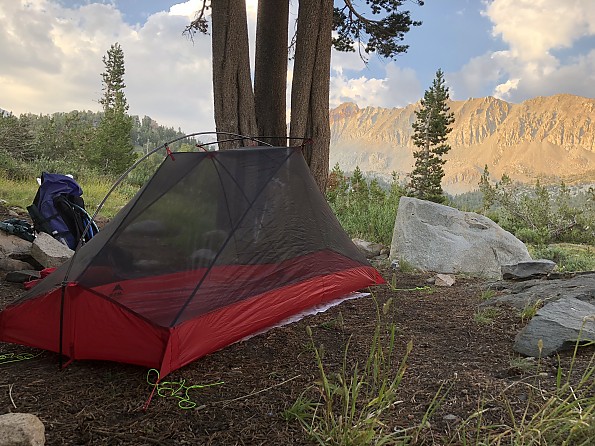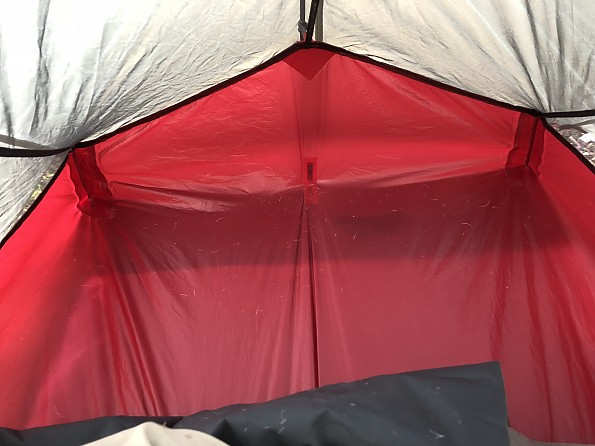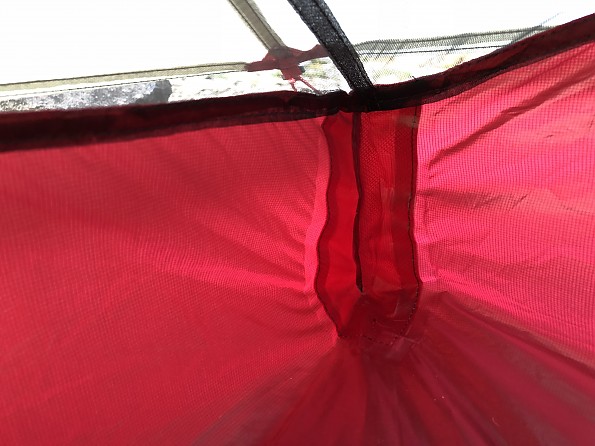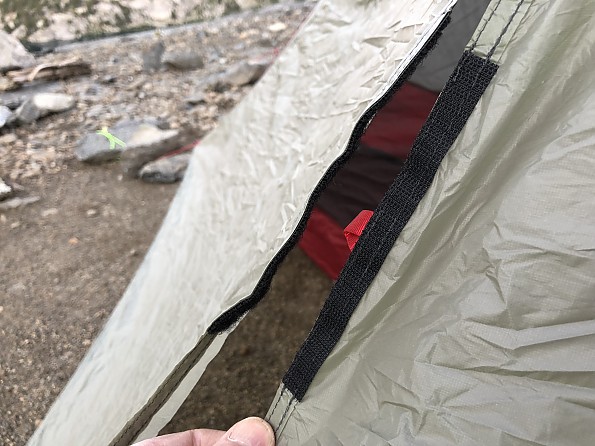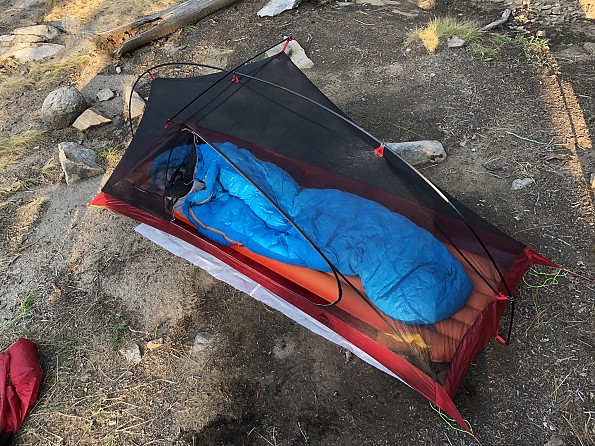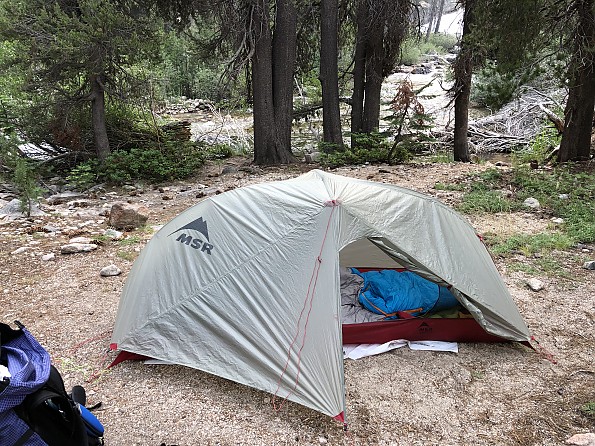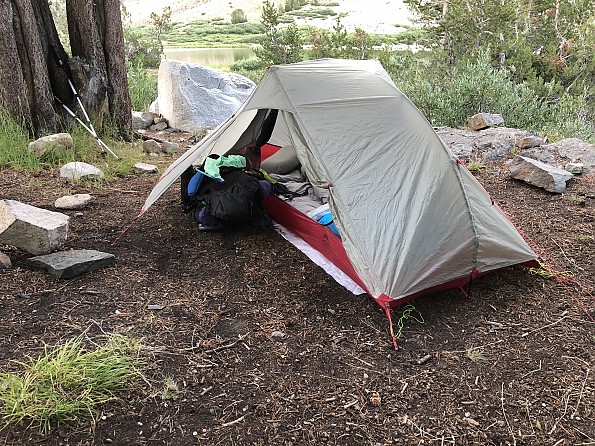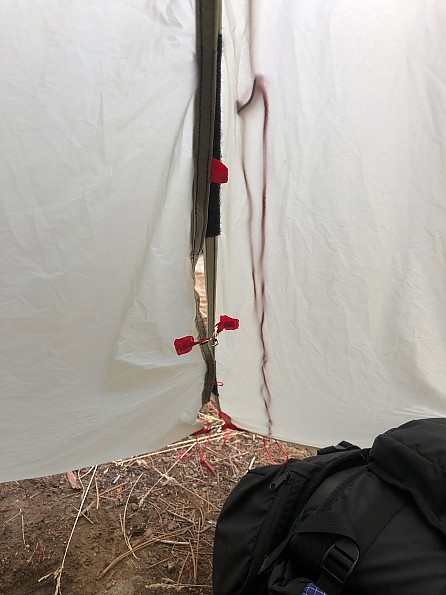MSR Carbon Reflex 1

The MSR Carbon Reflex 1 is a one-person, very light, and robustly constructed, three-season double wall tent that would make a great choice for the weight conscience backpacker whose focus is less on available space and more on shaving a few more ounces from the base weight of their pack.
Pros
- Fast and easy setup
- Competitive weight for the price
- Good use of reinforcements at all major stress points
- Compact size
- Quality construction
- Easton Custom Carbon 3.9 poles
Cons
- Minimal headroom to sit up for those 5'11" and taller
- Fly door closure—kind of funky
- Low to the ground door openings
Overview
The Carbon Reflex 1 is MSR’s lightest double-walled solo tent design. The tent is a non-freestanding configuration made utilizing ripstop nylon with DuraShield waterproof coatings for the rainfly and tent floor, and Micromesh netting for the upper tent structure. The tent has a typical bathtub style floor construction and all of the seams on the floor and fly have been seam-taped to be waterproof. The poles provided with the tent are made utilizing Easton Custom Carbon 3.9 carbon fiber composite pole sections which help make this a very light weight design.
I have structured this review into the four main sections listed below followed by a summary at the end.
1. The Basics of what is included with the tent
2. Physical Characteristics of the Carbon Reflex 1
3. Design and Construction
4. Living with the Carbon Reflex 1
The Basics of What is Included
The Carbon Reflex 1 comes packaged in its primary stuff sack as shown in the picture below.

Within the basic package get the tent, rain fly, poles, eight stakes, and three individual stuff bags for the stakes, poles, and overall package.
The tent and fly are provided with all of the reflective guy lines pre installed with tensioners / adjusters, so the tent is really ready to use right out of the bag.
MSR provides instructions for how to assemble the Carbon Reflex 1 both on the extra large flap of the main tent stuff sack and printed on the outside of the tent pole stuff sack. While a nice gesture on MSR’s part, the Carbon Reflex 1 is a very simple tent to set up and the instructions are not really needed beyond the first time the tent is set up, so while the instructions on the pole stuff sack don’t add any weight, I'm pretty sure the weight focused backpackers this tent is targeted at will cut off the flap on the tent stuff sack shortly after purchasing the tent.
Physical Characteristics of the Carbon Reflex 1
Weight
The primary selling point of the Carbon Reflex 1 is weight, so when I weighed the tent I found the measured weight to be right in line with the weights that MSR advertises for the Carbon Reflex 1. I have provided the actual values listed below that I measured compared against the MSR published weights.
Minimum weight:
- MSR published – 1 lb 7.0 ounces (23 ounces)
- Actual Measured: 23.3 ounces with all cords still attached (tent, fly, and poles only, and this did not include stakes and stuff bags)
Packed weight:
- MSR published – 1 lb 13.0 ounces (29.0 ounces)
- Actual Measured: 27.7 ounces (this included everything provided in the original package)
Weight of the individual components:
- Tent and guy lines: 9.6 ounces
- Tent stuff bag: 1.1 ounces
- Fly and guy lines: 8.4 ounces
- Poles: 5.3 ounces
- Pole stuff sack: 0.35 ounces
- Stakes (8): 2.8 ounces
- Stake stuff sack: 0.15 ounces
Sometimes it can get kind of confusing when manufactures publish the weight of a tent as a “minimum weight” and a “packed weight”, so I decided to include a link to the following MSR blog post "Understanding Tent Packaged Weight & Minimum Weight" on understanding published weights.
Packed Physical Size
The advertized size for the packed main stuff sack of the Carbon Reflex 1 is 17.0 inches long x 5.0 inches in diameter. I found that the tent could very easily be repeatedly packed into the numbers advertised by MSR with the 17.0 inch length really dictated by the collapsed pole assembly which is 17.0 inches long. The diameter that I measured was more along the lines of 4.25 to 4.50 inches.
In actual use I have been packing the tent and fly in the large stuff sack that was included which I would then pack inside of my pack. I have been packing the poles and stakes (in their stuff sack) in the stuff sack included for the poles and that would go in one of the side pockets on the outside of my pack. When broken down like this, I found that the Carbon Reflex 1 took up very little space in my pack and would pack very quickly, which I considered a big plus.
Assembled/Setup Size
The actual size of a tent when it is set up can vary significantly based on how much tension, etc. is applied to the tent while it is being set up. MSR provides some very basic dimensions for the floor length and width, overall height of the tent, and depth of the vestibule. I provided the actual dimensions I measured below compared to those advertized by MSR and in addition, I also provided the dimensions of features I feel are important but not provided by MSR, especially given how intimate of an experience it can be using the Carbon Reflex 1.
MSR published dimensions
- Length: 84.0 inches
- Width: 30.0 inches
- Overall Height: 34.0 inches (overall tent height based on my interpretation of MSR’s figure on their website)
- Vestibule depth: 24.0 inches
I found the actual dimensions for those featured listed above to be the following:
- Length: 83.0 inches on one side and 82.25 on the other
- Width: 29.25 on one end and 29.75 on the other
- Overall Height: 35.0 inches to top of poles
- Vestibule depth: 28.5 inches
In addition to the dimensions provided by MSR, I also recorded dimensions on the following features that I feel are important:
Interior Peak Height: 33.5 inches
- Tent Door Opening Peak Height from Ground: 32.0 inches
- Tent Door Opening Height from bottom edge of opening to top: 23.5 inches
- Tent Door Width: 36.0 inches
- Fly Door Opening Peak Height from Ground: 26.0 inches
- Sidewall Height – Center of tent at ends where poles attach: 11.0 inches
- Sidewall Height – Corners: 7.0 inches
- Sidewall Height – Sides at midpoint: 9.0 inches
Overall I found the Carbon Reflex 1 to be in-line with the dimensions quoted by MSR.
Design and Construction
Based on my experience with the multiple MSR products I have owned over the years, the one common characteristic I have found with all of their products is that they were robust functional designs and the Carbon Reflex is no different.
In general, the Carbon Reflex 1 design is similar to other double wall tents, but it seems MSR worked to find the sweet spot with this design to achieve a very lightweight tent with adequate space, that could be sold at a reasonable price, but incorporated robust design features that will allow the tent to last for a number of years . The tent utilizes a bathtub floor made from 15 Denier ripstop nylon with a 1200 MM Durashield coating, which is the same coating used on the fly that is manufactured using 7 Denier ripstop nylon. All the seams on the floor of the tent and the rainfly are seam taped for waterproofness.
As a side note, if you were wondering what a Denier is, it is the weight in grams of 9000 meters of a single strand of fiber used to make the fabric in question.
The following photo shows details of the bathtub floor that is typical of each end of the tent.
One common characteristic I observed throughout the design of the Carbon Reflex 1, was the use of reinforcements at high stress locations. In the picture below I’ve tried to show the extra layer of fabric MSR adds to each of the corners of the bathtub floor, which are also seam-taped.
Here is a picture of a typical corner detail from the outside of the tent showing the robust construction.

There is one seam that is seam-taped that does run across the floor of the tent near the midpoint of the floor and is shown in the photo below. The picture below also shows the nice reinforcement detail in mesh canopy where MSR added a patch of ripstop nylon to reinforce the two upper corners that contain the features that retain the pole the spans the width of the tent.

The rainfly also has similar seam taped fabric reinforcement at the points used to attach it to the upper cross pole of the tent.
Within the interior of the tent there are five loops for hanging gear. Three of the loops are distributed underneath the cross pole at the peak of the tent and then there is a loop at each end of the tent where the middle clip attaches to the main pole.
As stated earlier, the poles included with the Carbon Reflex 1 are made using Easton Custom Carbon 3.9 pole sections and are very light. On other tents I own with aluminum poles, I don’t bother with using a stuff sack to carry the poles to help save weight, but with the poles used on this tent I plan on using the stuff sack to help protect the poles from damage. Carbon fiber poles are great from a weight perspective, but they are very sensitive to damage, so it's worth the effort to make sure they stay protected.

Very minor nit—On the MSR website they list under Product Details in the list of features “Internal mesh storage pockets”, which implies there is more then one internal mesh pockets, where in reality there is the only one generous mesh pocket next to the door opening.
If there is one element of the Carbon Reflex 1 design that is questionable, it would be with the rain fly and more specifically with the method that MSR selected to close the door of the fly.
In general, the fly on the Carbon Reflex 1 is typical of rain flies used on other double wall tent designs. At a more detailed level, MSR did include a number of nice design details that help make the fly a robust design. There are more then enough attach points on the fly for even the harshest storm and all of the attach points on the fly are nicely reinforced and good quality cord tensioners are also included.
The fly also has three Velcro tabs along the inside of the fly to secure it to the primary pole along the crest of the tent to further help retain the fly in stormy conditions.
With the door of the fly, instead of a typical zipper like you might see on other three-season tents, the door of the fly on the Carbon Reflex 1 is secured by means of two small pairs of hooks and loops and two Velcro strips.
Being an engineer before I retired, my formal description of the door closure approach chosen by MSR for the Carbon Reflex 1 would be “kind of funky”. While there is some redundancy with the multiple hooks and Velcro strips, it really isn’t a robust closure due to the middle hook never really does anything as it always hangs loose when the Velcro is connected and seems like it would easily come unhooked in windy conditions. For most of the summer trips I go on this door closure system is more then adequate, but I haven’t yet used this tent in stormy/windy conditions to see how it will perform, but my intuition is that there may be issues compared to what you would be experienced with a zipper style closure.
I will add that I like that MSR tried a different design approach with the Carbon Reflex 1, but I’m not sure this was the right one. I think if MSR just included the single hook at the bottom, but installed it so that the corners of the fly opening were actually brought completely together when it was hooked and then used longer strips of Velcro without the middle hook, that they would have a winning design.
The stakes included with the Carbon Reflex 1 are the MSR Needle Stakes. While I generally prefer to use a hook style stake because I can insert them by hand in most cases, I did find the stakes that were included worked well and the hooked end easily accommodated both the cord loop from the corner of the tent and the rain fly with room to spare.
Living with the Carbon Reflex 1
First off, I’ll admit that it took me a few nights to develop a routine with the Carbon Reflex 1. This is the first time I have used a single person tent on a backcountry trip and it took a few nights to get into a rhythm of where to put gear and develop a little muscle memory in getting in and out of the tent so I wouldn’t catch my back on the fly and door openings. Once I became one with the Carbon Reflex 1, I started to appreciate the functionality of the design and would not hesitate to bring this tent on future trips.
Even though the Carbon Reflex 1 is a small tent and the rainfly provides good low coverage around the perimeter of the tent, the ventilation within the tent seemed good, as I never really experienced any issues with condensation
The tent is very quick and easy to set up, which is a strong point with this design. The process to set up the tent is very straightforward and involves first staking out the four corners of the tent so the floor is taut, then installing the primary pole that forms the backbone of the tent, then the short cross pole at the crest, and then attaching the fly. In practice it only takes a minute or two to get the tent fully set up.
While the Carbon Reflex 1 is not a free standing or even a partial free standing tent, in a pinch it still can be set up pretty easily in an area where you can’t drive stakes into the ground if you have a supply of rocks handy. The photo below is from a camp I made just above Rae Lakes in the Sierras. I got into camp early evening, was kind of beat, and the first spot I found was on a rock slab, so that’s where I decided to make camp. I always carry 50' or 60' of very light cord and all I had to do was add some large loops to each of the corners of the tent that I could then slip over rocks which enabled me to anchor the four corners and then set up the tent normally from there.


Floor space in the Carbon Reflex 1 is actually pretty good, definitely livable, and maybe even spacious from a length perspective. The picture below is from one trip where I was using my Klymit air mattress, which is the standard 20" x 72" configuration, and it gives you a good idea of the space remaining at the head and foot areas. 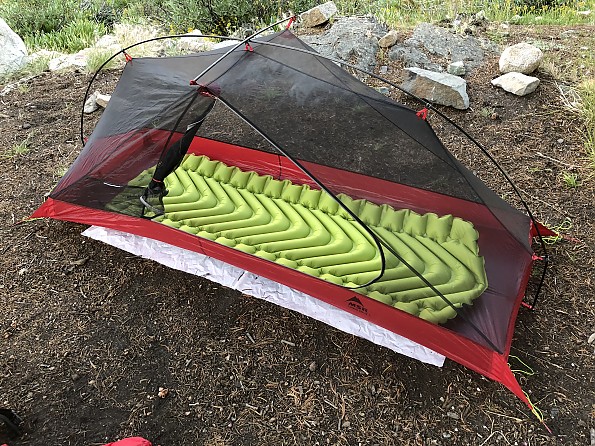
The next photo is from a trip where I was using my Big Agnes Air Core Ultra, which is a 20" x 78" mattress and it also easily fits within the Carbon Reflex 1 with room to spare.
The one thing that took me a while to get used to was the low door height. As I stated earlier, the peak of the tent door opening is about 32" from the ground, but that is really to the peak of a triangle, and when you are using the opening your body needs to be six inches or so below that point to keep you from catching on the door opening. If you are using a thicker air mattress, that can compound the issue.
With the fly installed the height of the opening of the fly is only about 26" which is pretty low compared to other tents I own, so it took me a few days before I got into the habit of getting low enough so I wouldn’t get hung up in the door openings. I am 5'11" tall, so if you were shorter you would probably find it less of an issue and if you were significantly taller it might be a deal breaker. The following photo is with the fly installed to give you an idea of what the size of the door opening looks like.
The next item that is worth discussing is the interior peak height. I found the interior peak height to be about 33.5 inches and it initially was annoying because I could never really ever sit straight up when I was in the tent, especially if I was sitting on an inflated mattress. Over a few days I eventually learned to hunch over and life went on.
To get a double wall tent to be this light I understand that there needs to be some compromises, but I wish the MSR designers could have squeaked in another inch or two to the peak height of the tent. Again for people shorter then me I doubt they would have an issue, but for me I probably wouldn’t take this tent on a trip where there was a good chance I could get stuck in the tent for several days due to bad weather, as not being able to sit straight up for a couple of days wouldn’t be tolerable.
The Carbon Reflex 1 has a typical vestibule design and I found the space covered was more then adequate for my typical gear. My pack is a medium size ULA Catalyst and I generally have a base weight of about 18 lbs. By the time I pull out my BV450 bear canister and make camp, there really isn’t a whole lot left in my pack, so I’ve found that it fits easily within the vestibule leaving plenty of space for me to get in and out of the tent. Someone who tends to carry a bigger pack may find the vestibule a little on the small size, but I think most backpackers focused on weight and therefore carrying minimal gear would find the vestibule more then adequate.
Closing the fly opening from the inside of the tent is a little more involved and somewhat awkward as you have to hook two sets of hooks and loops together and stick together two strips of Velcro to get the door completely closed. If you expected more stormy conditions then you really need to focus on getting the Velcro aligned and 100% attached so it can do its job at keeping the fly closed. For the trips I have used this tent on, there really hasn’t been any adverse weather, so on most nights where I did have the fly on the tent, I would just hook together the two sets of hooks and call it good.
If you were expecting windy conditions from a specific direction then you’d want to consider orienting the tent to avoid the vertical flat side of the tent or the fly opening facing the oncoming wind.
As I stated earlier I haven’t yet used the Carbon Reflex 1 in stormy conditions, but when I do I’ll make sure to come back and update my review to report on how the fly closure design performed.
Additional configuration options once you own a Carbon Reflex 1 tent
While I just used a piece of 2 mil plastic for a footprint while using this tent, MSR does sell a footprint for the Carbon Reflex 1 that can be used alone with just the poles and fly to be a very lightweight option. MSR also offers another newer option called the Carbon Reflex Fast & Light Body that looks very intriguing, as it is a tent body without any mesh. With this configuration you still have all the benefits of a bathtub style floor, but without the mesh you end up with significantly more headroom all the way up to the fly and a lighter weight package compared to the baseline Carbon Reflex 1. I think this is a great combination and something I would be interested in evaluating in the future.
Here is a link to the MSR webpage on the Carbon Reflex Fast & Light Body: https://www.msrgear.com/tents/backpacking-tents/carbon-reflex-fast-light-body
Price
The list price of the Carbon Reflex 1 is $399.95, which I think is a fair price given the quality of construction and how lightweight the tent is for a double wall design. I have seen the tent at times on sale for as low as $299, which would be a great deal for this tent.
Summary and Recommendation
After spending a significant number of nights in the Carbon Reflex 1, I’ll openly admit that I’ve developed a special bond with the tent and would recommend it as a very good choice for someone looking for a lightweight three-season tent and who prefers a double wall design. While the fly closure may not be perfect, the overall design, ease of setup, and the robust design details really make this a solid tent that will provide many years of enjoyable use.
Many thanks to both Trailspace and MSR for the opportunity to evaluate and test the MSR Carbon Reflex 1 for the Trailspace Gear Review Corps!
Source: received for testing via the Trailspace Review Corps
(Sample for testing and review provided by MSR)
This is a very impressive tent from MSR. It is a bit expensive so I gave it 4.5 stars instead of 5, but wow, this is a great tent. If you go backpacking more than twice a year, I would say it's worth the price. It is a very light tent, yet pretty sturdy... all thanks to the carbon fiber poles. Check out my video review to see the tent in action and learn more about the Carbon Reflex 1.
Pros
- Lightweight
- Well-made
- Weather proof
Cons
- Pricey
Source: tested or reviewed it for the manufacturer (I kept the product after testing.)


